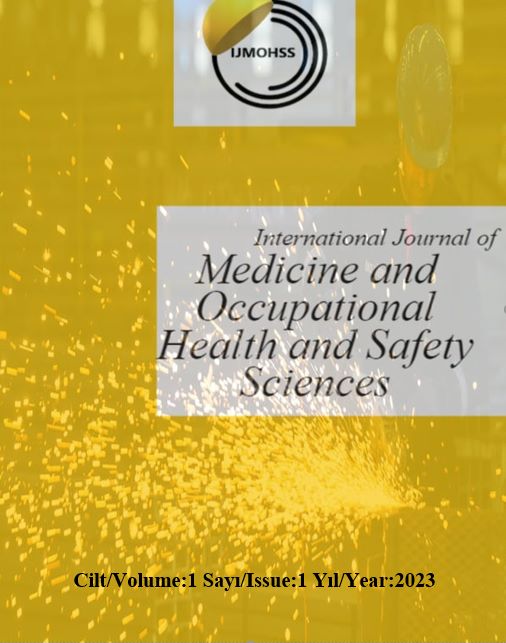Occupational Safety in the Private Security and Protection Sector, Risks Encountered and Risk Analysis
Keywords:
Fine-kinney, Private security and protection, Risk analysis, Work safetyAbstract
The assessment of occupational risks is very important in the field of occupational health and safety. The aim of this study is to assess the risk factors related to the safety and health parameters of employees of private safety and protection at work. Risk scores using Fine-Kinney method, which is widely used in risk assessment; It was calculated without sampling using probability-frequency-effect values. Based on this data; To protect the mental and physical integrity of private safety and protection employees, the work environment should be ergonomic, pleasant in terms of sound and heat, illuminated to facilitate visibility and free from situations that could create physical barriers, safety signs and signs should be placed so that they are clearly visible, appropriate protective equipment should be provided, should be trained regularly. If these parameters are taken into account, the risks of possible accidents or occupational diseases of the employees of the private security and protection service could be minimized.
References
J. De Waard, Eur. J. Crim. Policy Res. 7 (1999) 143–174.
M. Button, B. George, Secur. J. 2001 141 14 (2001) 55–66.
F.A. Suárez Sánchez, G.I. Carvajal Peláez, J. Catalá Alís, Ind. Health 55 (2017) 210.
P.A. Schulte, G.R. Wagner, A. Ostry, L.A. Blanciforti, R.G. Cutlip, K.M. Krajnak, M. Luster, A.E. Munson, J.P. O’Callaghan, C.G. Parks, P.P. Simeonova, D.B. Miller, Am. J. Public Health 97 (2007) 428–436.
G. Carvajal Peláez, Modelo de Cuantificación de Riesgos Laborales En La Construcción: Ries-Co, Universitat Politècnica de València, 2009.
N.G. Mutlu, S. Altuntas, Int. J. Ind. Ergon. 72 (2019) 222–240.
P.K. Marhavilas, D.E. Koulouriotis, C. Mitrakas, J. Loss Prev. Process Ind. 24 (2011) 671–687.
A. Özmen, Z. Altıparmak, B. Konuklar, Ö. Doğru, R. Ertuğrul, Çalışanların Gürültü Ile İlgili Risklerden Korunmalarına İlişkin Uygulama Rehberi, Ankara, 2018.
A.M. Yuyucu, Emek ve Toplum 6 (2017) 399–407.
P.K. Marhavilas, D.E. Koulouriotis, J. Loss Prev. Process Ind. 21 (2008) 596–603.
B. Gür, B. Yavuz, Ş. Çakır, A.D. Köse, Eur. J. Sci. Technol. (2021) 497–511.
G.L.L. Reniers, W. Dullaert, B.J.M. Ale, K. Soudan, J. Loss Prev. Process Ind. 18 (2005) 127–138.
G.F. Kinney, U.S. Naval, A.D. Wiruth, Nav. Weapons Cent. 20 (1976) 1–25.
M. Oturakçi, C. Dağsuyu, Karaelmas J. Occup. Heal. Saf. 1 (2017) 17–25.
F. Erdoğan, Z. Bayramoğlu, Araştırma Makal. 3 (2017) 19–28.
N. Zairani, M. Zaini, M. Ariff, M. Salleh, M.F. Hasmori, V. V Kuleshov, Y. Skuba, I.A. Ignatovich, IOP Conf. Ser. Earth Environ. Sci. 720 (2021) 012094.
W. Wang, Y. Wang, S. Fan, X. Han, Q. Wu, D. Pamucar, J. Pet. Sci. Eng. 220 (2023) 111246.
Ö. Özkılıç, İş Sağlığı ve Güvenliği, Yönetim Sistemleri ve Risk Değerlendirme Metodolojileri, 2005.
Ö. Cavkaytar, Ö. Uysal SOYER, B. Enis ŞEKEREL, H. Üniversitesi, T. Fakültesi Çocuk Allerji Bölümü Sıhhıye, Hava Kirliliği Araştırmaları Derg. 2 (2013) 17.
R.L. Daft, Organization Theoryand Design, 2008th ed., South-Western Cengage Learning, 2008.
W.A. Shewhart, Statistical Method from the Viewpoint of Quality Control, 1939th ed., The Graduate School, The Dept. of Agriculture, Washington, 1939.
Downloads
Published
How to Cite
Issue
Section
License
Copyright (c) 2023 International Journal of Medicine and Occupational Health and Safety Sciences

This work is licensed under a Creative Commons Attribution 4.0 International License.



